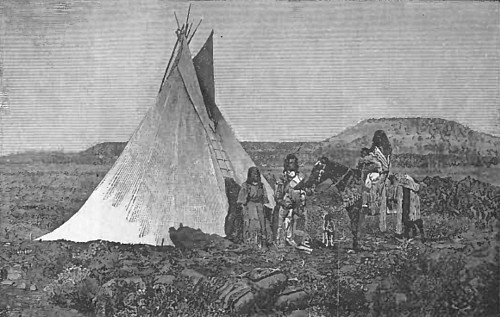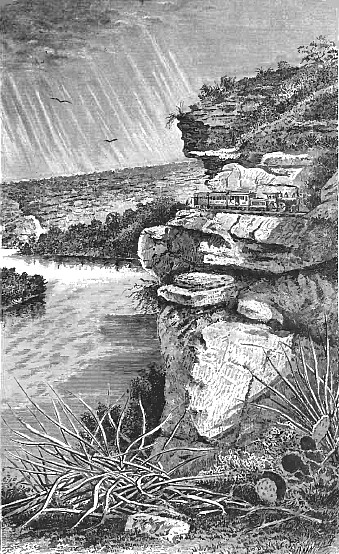The United Verde at Jerome generally is considered the richest copper mine in Arizona, though not the largest, measured in pounds of product or in area. Nearly wholly owned by former Senator W. A. Clark of Montana, it is understood to be worth several millions a j-ear net income. Yet the mine before Clark's ownership had a history of financial disaster. Credit for the first mining location in the Black Hills section has been given to the noted prospector Al Sieber. who, in 1877, staked out a claim he called the Verde. This mine later was owned by the Verde Queen Company, which found little profit in the operation of a small smelting furnace. This mine and good looking croppings nearby, about where Jerome now stands, were visited the same year by George W. Hull, who, years later, was pleased to own extension on the ground he had passed over. Two claims on these croppings were located in 1877 by John Dougherty and Capt. J. D. Boyd and there was organized the Verde Mining District, with G. V. Kell as recorder. The next year three adjoining claims were located by M. A. Ruffner, who, with Rod McKinnon, did much work oil the Eureka and Sleeping Beauty mines. In 1882 the mines were examined by F. F. Thomas, who had been told in Prescott, by Angus McKinnon, that he and his brother had a fine copper mine in the Black Hills, about twenty-five miles distant. This was the Wade Hampton, where Angus and John McKinnon had sunk a forty-five foot shaft and a short drift. The prospect looked good and so an agreement was made to pay McKinnon $500 cash and $15,000 December 1. Thomas employed the McKinnons, who seemed to be afraid to sink for fear of knocking the bottom out of
their mine and spoiling a good prospect. Thomas foreseeing the prospect of a big mine by consolidation of several claim, thereafter bonded the adjoining Eureka mines from Charles Leuuig of Philadelphia, the Hermit claim from Ruffner and the McKinuons, the Azure and Adventure Chromes from Judge Riley of Nevada and his nephews, in all getting possession of eleven claims, as well as title to a spring in Walnut Gulch. Nearly all had good copper croppings, but some showed only iron, zinc and lead sulfide, with low assays in silver and native gold. In the same year George A. Treadwell, later noted as a mining expert, was taken to see the property and became enthusiastic over it, later acquiring an interest in the ground.
Securing the necessary money for making the bond payments was not easy, and the month of December was spent by Thomas in chasing around eastern financial centers and trying to interest capital. The McKinnon bond had been extended to January 1, by which date Thomas had telegraphed $7,500 to the McKinnons.
The incorporation of the United Verde Copper Company was effected in 1883, with James A. McDonald, president, and Eugene Jerome as secretary and treasurer, -with Thomas superintendent and general manager, authorized to install reduction works, build a road and operate the property. Thomas left New York March 23, 1883, and soon thereafter started the first fifty-ton furnace, which made a phenomenal run on oxidized silver ore, high with silver. Thomas had already surveyed the town site, which he named after the company's secretary. While the mine was wonderfully rich, reduction processes of that day had not developed to the point wherein its ores could be handled profitably. Within a year the company had paid $62,000 in dividends out of a total production of $779,000 worth of copper. This came mainly in the form of a 60-per cent matte, in which was considerable gold Transportation was even as much trouble as the refractory ores and so, late in November, 1884, when copper had dropped to about seven cents a pound, and when snow covered the Black Hills divide, over which the hauling had to be done to Ash Pork, the mine was closed down. In the summer of 1887, Governor Tritle secured a bond and lease on the property from the United Verde Company, but soon found the same distressing conditions bearing down on him that had confronted the previous management. According to G. W. Hull, locator of adjacent property, "the men at the mine not being paid their wages, took possession and threatened to destroy the plant." Some sort of settlement was made, and then the mine was on the market. Prof. James Douglas examined the property, but considered it too remote from transportation. Following him came W. A. Clark of Montana, accompanied by John L. Thompson and J. L. Giroux. In February, 1888, Clark leased the property, and in January, 1889, after Giroux had made full investigation and a number of smelter runs had been made, Clark purchased control of the company. A narrow-gauge railroad was completed in November, 1894. over the hills and down a tortuous valley'. About the same time fire started in a sulfide slope and even today there is trouble from this source. In October, 1900, was a serious cave-in that dropped a large part of the reduction works and railroad grade about five feet. In the early Clark days, a tunnel struck an immense body of water.
Clark's capital and the skill of his managers soon put the mine on a paying basis. It was appreciated, however, that the reduction works and slag dump should not be on top of the mine, so plans were made for a new reduction plant in the valley, where the Town of Clarkdale now is in being, supported by the operation of a smelter that alone has cost $3,000,000, with a broad-gauge railroad connecting with the Santa Fe system, and with a wonderful railroad leading into the mountain on the mine's 1,000-foot level. The old smelter above Jerome was abandoned in September, 1915.
COPPER DEPOSITS.
Arizona is almost as famous for its copper mines as for its deposits of
silver and gold. The ores are widely distributed and of high grade, often
yielding from 60 to 80 per cent of metal. Production on a large scale began
in 1881, from which date the total product per year was about six,
seventeen, twenty-five, and perhaps thirty-five million pounds in 1884.
Leading mines, or groups, are the Planet, Centennial, and Copper King of
Bill Williams River in northern Yuma;
the United Verde Company's mines in the Black Hills of Yavapai; the Globe district lodes of Gila; the old Ajo mines in western Pima ; and the Copper Queen and others of Bisbee in southern Cochise. But at the head of all stand the wonderful copper deposits near Clifton in Graham county, where rich ore is quarried rather than mined, and whence a railroad has been built to carry the product to the main line of the Southern Pacific. The vast resources of Arizona, in copper, must make her one of the richest mining regions in America. At Bisbee, in Cochise county, are the rich deposits of the Copper Queen mine, and a host of other promising properties. The Queen's vein is one hundred and twenty feet wide, and the ore averages twenty-two percent, pure copper metal; consisting of a green malachite carbonate and a red cuprite oxide. Two thirty-ton smelters are turning out thirteen tons of pure copper daily, and the mine has produced $2,000,000 up to January, 1883, with 74,000 tons of ore in sight. Pima county has rich copper ores, in the Santa Rita range, twenty-five miles south of Tucson. The veins vary in size; some being nearly fifty feet wide, yielding fifteen to twenty per cent of pure copper. The Silver Bell district, in this county, has immense deposits of copper. Yavapai county contains high grade copper ores, in various places. In the Black Hills, twenty-five miles north-east of Prescott, these ores are being mined from veins eight to sixteen feet wide. In Pinal county, on Mineral Creek, northeast of Florence, are many rich copper mines. The veins vary from seven to fourteen feet in width, and are said to average twenty-five per cent, pure metal. In both Mohave and Yuma counties, there are also rich deposits of copper. In the Bill Williams Fork district, the Planet mine has produced 6,000 tons of copper ore, which has yielded from twenty to sixty per cent, of pure copper. In Graham county, the Longfellow copper mines are already famous. A mountain of the mineral has been discovered here, and ore is encountered in whatever direction drifts and tunnels have been run, while thousands of tons have already been taken from the mines. It is doubtful if there are any deposits of copper in the known world superior to those Arizona possesses.
Return
to The Arizona Page:
Arizona Gold Rush Mining History



